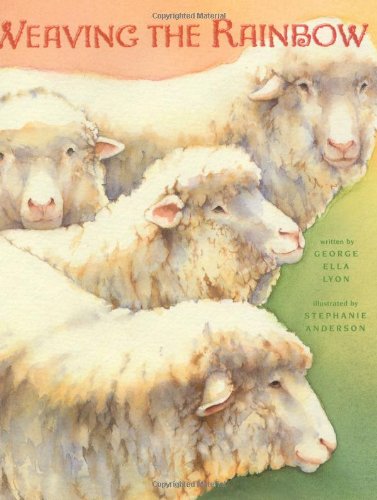
George Ella Lyon is my favorite children’s author, and in “Weaving the Rainbow” she almost hides a riddle. She describes sheep in a pasture, and follows them through the seasons. They lead ordinary sheep lives, “But they were getting closer to the rainbow,” Lyon writes. The next page describes fall, and it features colorful leaves. But it’s only on the final page that the real rainbow is revealed.
It’s another children’s book with lavish watercolor illustrations. Even on the book’s inside cover, there’s four shades of green in a spectacular field, plus a white picket fence and blue skies in the distance. “The weaver” looks proudly on the sheep in her pasture. And fall brings red leaves – and shaggy fur for the sheep.
But it’s easy to see how the illustrator was inspired by Lyons’ text. “It is spring now. It is shearing time,” she writes simply – but those words suggest rich illustrations. And when the sheep were born, their coats were white, Lyon writes. They’re turned out into “April fields”, and they even win ribbons at the state fair. The sheep’s lives pass by quickly, because the book is not about the sheep – it’s about their wool!
Lyon describes the sheared wool coming off in one piece, “white and springy,” and it’s brushed and then twisted into yarn. The weaver dyes the yarn, and hangs loose coils of color on the branches of a blossoming tree. When describing her dyes, Lyon uses colorful words that are also the names of plants – like indigo and goldenrod – simply listing them on the page, like lines of a poem. And then she adds a poetic line of her own. “She is cooking up a rainbow.”
Ultimately, there’s beautiful illustrations of the colored yarn, stretched for the weaving shuttles, “back and forth, back and forth.” And in the text, the words about nature seem to also be words about colors. “From the wool of her white sheep she weaves Kentucky pastures, grass green, evergreen, willow yellow, redbud, purple shadow, shy sky blue.”
She’s “doing with wool what a painter does with paint,” Lyon adds wisely. In a wonderful irony, the artist weaves little lambs into her tapestry – using the white wool that she’d sheared from real lambs.
Only then can the reader understand the strange drawing on the book’s copyright page. It’s another view of the field from the book’s inside cover – now including sheep. But as the drawing moves to the page’s right side, the drawing suddenly starts to fade into a faint grid. At the end of the, its meaning is clear: it represents the crisscrossed crocheting in the weaver’s final tapestry.